




| Home | Features | Club Nights | Underwater Pics | Feedback | Non-Celebrity Diver | Events | 8 August 2025 |
| Blog | Archive | Medical FAQs | Competitions | Travel Offers | The Crew | Contact Us | MDC | LDC |

|

|
 
 |
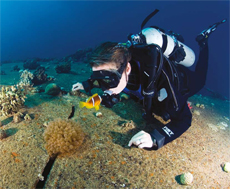 |
ISSUE 9 ARCHIVE - THE SEA DOC INVESTIGATES: WRECKS VERSUS REEFSDr John CarlinMy name is Dr John Carlin and I am a Marine Biologist, PADI Course Director, volunteer Presenter for the Shark Trust and owner of the Aquatic Element Dive Centre. I have been asked to write a quarterly column about different aspects of the underwater world and marine conservation.My first article is to answer the battle cry started by my fellow diving professional and personal friend, Alex Griffin author of the highly amusing and factually correct (at times) 'Diving Deepravities'. |
 |
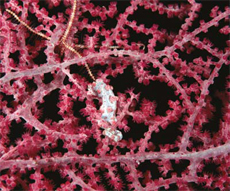
|
In Issue 7, Alex highlighted the long running argument that
can divide many diving clubs the 'Wrecks versus Reefs'
debate. Alex believes that divers can fall into two groups;
those who are 'wreck divers', who live life on the edge and
listen to Metallica and 'reef divers', who play it safe, wear
sandals and listen to Snow Patrol. I feel that as I own several
Snow Patrol and Metallica albums that I can put forward
a balanced yet unbiased argument as to why reefs are
so important, interesting and why reef diving can be as
exciting as wreck diving.
The word reef describes a narrow ridge, chain of rocks, shingle or sand lying at or near the surface of the water. So why is this of interest to you as the reader and how is this going to swing you in favour of reefs? |
|
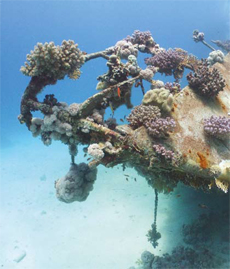
|
Well, the world's oceans contain an astonishing array of life;
from microscopic species such as plankton, which are the
base of the marine food chain, right up to the blue whale, the
largest animal that has ever lived. In 1997 it was estimated
that the world's ecosystems (excluding non-renewable fossil
fuels and the atmosphere) provided, on average, at least $33
trillion dollars worth of services annually. About 63% of this is
contributed by marine ecosystems ($20.9 trillion dollars).
Not only do the world's oceans provide incomes and livelihoods
for over 200 million people, they are also an important source
of food to over a billion people, contributing, in the way of fish,
about 17% of the animal protein in the human diet.
One of the most important parts of the aquatic ecosystem is the 'coral reef' and there is something breath-taking about a tropical coral reef. The warm, clear water, vibrant colours and the vast array of living organisms that inhabit this spectacular ecosystem are a sight to behold. Coral reefs are said to be the most productive, mature, diverse and complex ecosystems in nature. They rival that other great tropical community, the rainforest, in both their beauty and diversity and have been labelled 'the rainforests of the sea' with the corals and fish being equivalent to the trees and the birds. |
 |
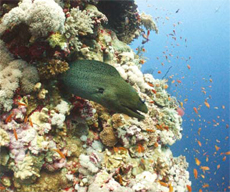
|
Out of all the marine ecosystems the coral reefs are the most
biodiverse with estimates of up to 9 million different species
inhabiting coral reefs worldwide. More than two-thirds of our
planet is covered by oceans and only a tiny proportion (<1%)
of this vast marine environment harbours coral reefs. This is
primarily because of the narrow physiological tolerances of
the reef building corals. Despite this, coral reefs arguably
hold the record for the largest structure on earth made by
living organisms: the Great Barrier Reef, in Australia, which is
approximately 2000km long. These underwater landscapes,
which occupy such a minute part of the vast ocean system,
harbour about 25% of marine species.
|
|
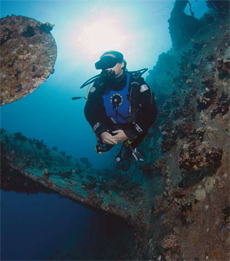
|
Coral reefs are major biological features on the earth's
surface. Although they cover only about 0.2% of the world's
ocean area, 15% of the seabed between the 030m depth
range is made up of living reefs. Shallow water living coral
reefs are estimated at present to cover over 600,000km2.
Their biological productivity per square metre is usually 50 to 100 times more than in the surrounding tropical ocean waters. As with the rainforests, the importance of coral reefs is not so much the diversity of the corals themselves but with the number of species that live in or associate with them. For example, there is a minimum estimate of 835 species of reef-building corals and estimates for the biodiversity of reefs range from 19 million species. Weirdly coral reefs require clear, nutrient-poor water and this is an interesting paradox as they are among the most productive and diverse of marine environments and so can be thought of as a 'marine oasis'. The coral animals are able to grow so well because of the abundant algae, commonly known as zooxanthellae, with which they associate. They are home and nursery to almost a million fish and other species, many of which we rely on for food. |
 |
|
Coral reefs even mirror the rainforests' importance in chemical
cycles. They influence the chemical balance of the seas by
binding roughly half the calcium which enters the world's
oceans and with each atom of calcium a molecule of carbon
dioxide is also deposited. They have an estimated carbon
dioxide fixation of 700 billion kg of carbon per year.
With almost 8 percent of the global population living within 100 kilometres of a coral reef, they are not only an important source of biodiversity for nature but are of high value for mankind. They support nearly 500 million people who rely upon coral reefs and their natural resources for food, coastal protection, cultural items, materials for new medicines and tourism income; 30 million of the poorest people depend entirely on coral reefs for food. Estimates show that they provide nearly US $30 billion worth of net benefits in goods and services to the world's economies. One example of how valuable a reef can be is the Great Barrier Reef in Australia which is valued at US $4.3 billion dollars annually, this generated by a variety of activities such as tourism, commercial fishing, and cultural and recreational activities. Several of my friends who are avid wreck divers often comment that whilst diving over a coral reef might be a 'pretty dive' it all begins to look the same and gets boring quite quickly. They say that the same cannot be said for wrecks which have different locations and reasons for their presence on the seabed. Even the way a wreck has come to rest on the bottom (upright, upside down or on its side) can be different and the ability to glide above and inside a wreck encourages the diver to imagine what it must have been like on the surface, adding to the excitement of diving on a wreck. There is also the historical aspect of wreck diving learning about how the ship met its watery grave. My counter-argument for the reef diving being boring is that quite often it is a visual overload when you are swimming over a reef. There is so much going on that you are unable to take it all in. The reef is a myriad of interactions and relationships between all sorts of species from algae to corals, fish, molluscs, turtles and many other plants and animals. There are several tricks you can use to appreciate their beauty. The first is to simply slow down. Do not rush your dive on a reef in fact you will often see more if you just stay still. I will often just try and find a spot to hover over and wait for a minute or two and then, just like one of the magic-eye pictures you used to have stare at before something would pop into view, all the marine life will slowly start to appear again. If you are on a reef where there are sandy patches, even these can be full of life. At first you may just see grains of sand, but if you wait long enough you could see garden eels start to poke their heads out of their burrows and sway in the current looking for food. Also see if you can spot something called a Shrimp goby. This is a small fish which lives in a burrow with a type of shrimp. They have a fascinating partnership where the shrimp spends the day digging the burrow in which they both live and the fish which has better eyesight than the shrimp stands guard. If you look carefully at the shrimp and the fish, they maintain a constant contact where the shrimp places one of its antennae on the tail of the fish. If there is danger the fish alerts the shrimp by flicking its tail and they can then both disappear into the burrow. |
 | |
|
The second trick is to learn a little about the types of plants
and animals that are found on the reef that you will be diving
on. There are now many great regional reef identification
books and courses which will help you develop a better
understanding about different species; looking at the habitats
they live in, how they feed and interact with other species.
There are many interactions on the reef from the anemone and the clown fish, the corals and their symbiotic algae, to the cleaning stations where you will find cleaner wrasse providing a valet service to other fish to keep them healthy and free of parasites. The next time you are diving see if you can spot a cleaning station and you will be amazed at the different types of fish that come in and how they queue up. Now that many people are diving with digital cameras you can take a picture of something you haven't seen before and then once you are back on the boat or dry land try to identify it with the help of the dive guide and reference books. Finally an interesting side to the 'Wrecks versus Reefs' debate is that many of the fantastic wrecks that we dive on today would not be there if they hadn't come aground on a reef. As many readers will have dived in the Red Sea you just have to look at Abu Nuhas reef in the Northern Red Sea which has caused four to seven casualties (depending on who you speak to) resulting in some of the most amazing wrecks to dive on; from the photogenic old-timer that is the wreck of the Carnatic to the bulky Greek freighter that is the Giannis D. Wrecks over a period of time also get reclaimed by the sea. They will often provide shelter and protection to animals and plants evolving to become artificial reefs. More and more ships are now being stripped and sunk to create not only sites for divers to go and explore but also as artificial reefs to create new habitats for marine life. This helps to take some of the pressure of fishing and tourism away from the natural reefs to allow them to recover. One of the most recent of these purposesunk wrecks was the USNS General Hoyt S. Vandenberg (TAGM10) which on the 27th May 2009 became the world's second largest artificial reef (after the aircraft carrier USS Oriskany) when she was laid to rest at Key West in Florida. The Vandenberg has become a magnet for marine life and within six months was starting to become covered with plants and invertebrates that have helped to develop a food chain for fish such as grouper, snapper and barracudas. I believe that the battle lines between 'wreck' and 'reef' divers are becoming blurred. My wife, Katie, was once a committed reef diver until she did a dive on the MV Robert which in 1975 sank just off Lundy Island (a marine national park in Devon). Katie declared she could see why people enjoyed wreck diving because the MV Robert had become a reef in itself covered in anemones, nudibranchs, pipefish, crabs, schooling fish, conger eels and one of the biggest lobsters she had ever seen. So ultimately, whether you are a wreck diver or a reef diver it is almost irrelevant as any wreck in time evolves to become a reef just in a different shape. In essence all wreck divers are really 'immature reef' divers and it just boils down to the type of music you like and your choice of foot wear. Photography by Richard Potter and Chris Sterritt |
 | |
Previous article « Lundy Island Next article » Take a Look at Tech Kit Back to Issue 9 Index | ||